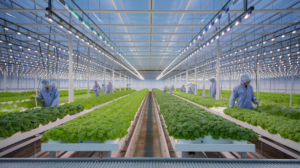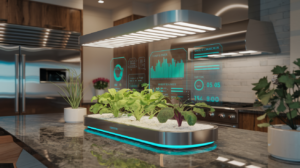Hydroponics, the art of growing plants without soil, has come a long way since its ancient origins. Today, we stand on the brink of a revolution in this field, with AI and blockchain technologies poised to transform home gardening. This article explores the fascinating journey of hydroponics from its historical roots to its promising future, highlighting how companies like FreeBonde AB are leading the charge in decentralized, AI-powered hydroponic solutions for households worldwide.
By Richard Peiheng Zhu
Urban farming / Hydroponics Expert / Content creator / Serial Entrepreneur / Member of Mensa Sweden / Member of Swedish Association of Inventors (SUF)

The Ancient Roots of Soilless Cultivation
The concept of growing plants without soil dates back to ancient civilizations. The Hanging Gardens of Babylon, one of the Seven Wonders of the Ancient World, is believed to have used a form of hydroponics. Similarly, the floating gardens of the Aztecs, known as “chinampas,” utilized a system of raised beds in shallow lakes to grow crops.

Key Milestones in Hydroponic History
• 1600s: Jan van Helmont’s experiments on plant growth • 1860s: Julius von Sachs develops nutrient solutions for plant growth • 1920s: William Frederick Gericke coins the term “hydroponics” • 1940s: Hydroponics used in World War II to supply fresh produce to troops • 1970s-1980s: NASA research on hydroponics for space agriculture
The Present State of Hydroponics
Today, hydroponics has evolved into a sophisticated industry with applications ranging from commercial agriculture to home gardening. Modern hydroponic systems utilize advanced technologies to optimize plant growth, conserve water, and maximize yields.
Current Applications of Hydroponics
- Commercial greenhouse production
- Urban farming and vertical gardens
- Home gardening and indoor cultivation
- Research and education
- Food security initiatives in arid regions
Comparing Traditional Soil Gardening vs. Hydroponics
| Factor | Traditional Soil Gardening | Hydroponics |
|---|---|---|
| Water Usage | High | Low (up to 90% less) |
| Space Efficiency | Low | High |
| Growth Rate | Normal | Up to 50% faster |
| Pest Control | Challenging | Easier |
| Nutrient Control | Difficult | Precise |
The Future of Hydroponics: AI and Blockchain Revolution
As we look to the future, companies like FreeBonde AB are working on innovations in the hydroponic industry. By integrating AI and blockchain technologies, we are exploring new possibilities in home gardening and indoor agriculture.
The FreeBonde AB Vision
FreeBonde AB is developing concepts for decentralized hydroponics for households. Our approach explores:
- AI-powered monitoring and control systems
- Blockchain technology for data security and transparency
- User-friendly interfaces for easy management
- Sustainable and energy-efficient designs
How to Get Started with Home Hydroponics
If you’re inspired to start your own hydroponic garden at home, here’s a simple guide:
- Choose Your System: Decide between a DIY setup or a pre-made kit
- Select Your Plants: Start with easy-to-grow herbs or leafy greens
- Prepare Your Nutrient Solution: Follow guidelines for your chosen plants
- Set Up Lighting: Ensure adequate light for plant growth
- Monitor and Maintain: Regularly check pH levels, nutrient concentrations, and plant health
Frequently Asked Questions
Q: Is hydroponic produce as nutritious as soil-grown produce?
A: Yes, studies have shown that hydroponic produce can be just as nutritious, and in some cases even more so, than soil-grown produce.
Q: How much space do I need for a home hydroponic system?
A: You can start with systems as small as a countertop unit or scale up to larger systems depending on your space and needs.
Q: Are hydroponic systems energy-efficient?
A: Modern hydroponic systems can be very energy-efficient compared to traditional farming methods.
References
- Barbosa, G. L., et al. (2015). Comparison of Land, Water, and Energy Requirements of Lettuce Grown Using Hydroponic vs. Conventional Agricultural Methods.
- Resh, H. M. (2013). Hydroponic Food Production: A Definitive Guidebook.
- NASA. (2021). Growing Plants in Space.
- Food and Agriculture Organization of the United Nations. (2019). The State of Food and Agriculture 2019.
#hydroponics #AIagriculture #sustainablefarming #indoorgardening #FreeBondeAB #futurefood #blockchainfarming #homegrown #urbanagriculture #smartgardening

